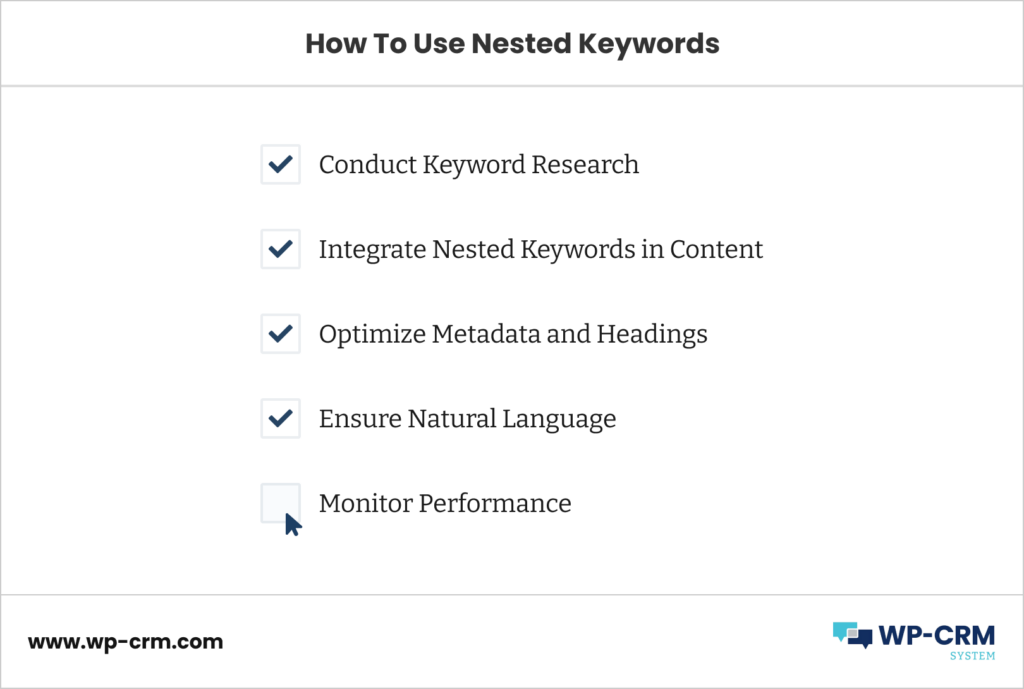What Are Nested Keywords for SEO?
Keywords play a crucial role in SEO. They help search engines understand the content of web pages and determine their relevance to user search queries. Traditional keyword optimization involves identifying and targeting specific keywords throughout a website. However, as search engines become more sophisticated, a new approach called “nested keywords” has emerged.
Nested keywords, along with long-tail keywords, are variations of search queries that contain your primary keyword but within particular context. When optimizing your content, you need to keep users in mind, as simply stuffing your pages with your main term will no longer cut it.
In this article, we will explore what nested keywords are, how they differ from traditional keywords, their benefits, strategies for implementation, and the importance of maintaining a natural language approach.
What Are Keywords in SEO?
Keywords are words or phrases that reflect the main topics or themes of a webpage‘s content. They help search engines match user queries with relevant online content.
Traditionally, keyword optimization involved strategically placing your money keywords across the website copy, headings, titles, and metadata of a webpage. This approach helped websites rank higher in SERPs for those targeted keywords.
Explaining Nested Keywords
Nested keywords, also known as semantic or contextual keywords, go beyond conventional SEO methods. They involve incorporating related and contextually relevant terms within the content of a webpage. Unlike traditional keywords that are specific and often stand alone, nested keywords are part of a broader semantic structure. For example, if the main keyword is “dog training,” nested keywords could include “positive reinforcement techniques,” “obedience commands,” or “puppy behavior.”
Benefits of Using Nested Keywords

Creating a list of nested keywords to ‘compliment’ your content comes with plenty of benefits for your overall online visibility. Here are the top ones:
1. Enhanced Targeting. Nested keywords allow for a more granular and precise targeting of specific search queries. By including related terms within the content, websites can attract users who search for more specific or long-tail variations of the main keyword. This can lead to increased relevance and higher conversion rates.
2. Improved Relevancy and Context. Search engines strive to deliver the most relevant results to users. By incorporating nested keywords, websites can provide more context and relevance to the user. This helps search engines understand the overall topic and intent of the webpage, potentially resulting in higher rankings for related search queries.
Let’s say you have a web page about “digital marketing”. If you include nested keywords like “SEO techniques,” “content marketing strategies,” or “social media engagement,” it signals to search engines that the content covers a comprehensive range of digital marketing topics. This, in turn, demonstrates your authority and thought leadership within the industry, which means that users will trust your brand more and possibly, convert into loyal customers!
3. Potential for Higher Rankings. Nested keywords can contribute to higher rankings in SERPs. When search engines recognize the relevance and comprehensiveness of a webpage’s content, they are more likely to rank it higher for related search queries. This increased visibility can lead to more organic traffic and exposure for the website.
For example, a web page targets the keyword “healthy recipes” By incorporating nested keywords like “vegetarian options,” “gluten-free alternatives,” or “quick and easy meals,” it has a better chance of ranking higher for those specific recipe variations.
How Can You Use Nested Keywords?

Conduct Keyword Research
First things first, start with a comprehensive keyword research to identify the main keyword you want to rank for and its variations. Use tools like Google Keyword Planner, Semrush, or Moz to discover related terms and phrases that users commonly search for. Look for keywords that have a natural connection to the main topic or theme.
Integrate Nested Keywords in Content
Once you have a list of nested keywords, strategically incorporate them into the content of your webpage. Ensure they flow seamlessly and are contextually relevant to the main topic. Avoid keyword stuffing or over-optimization, as this can negatively impact the user experience and search engine rankings.
Optimize Metadata and Headings
Include nested keywords in the metadata and headings of your webpage. This helps search engines understand the overall theme and relevancy of the page. Optimize title tags, meta descriptions, and headings by incorporating related terms where appropriate.
Ensure Natural Language
While using nested keywords comes with a lot of positives, make sure you don’t overuse them as it’s important to maintain a natural language approach. Therefore, avoid keyword stuffing, which is the excessive use of keywords in an attempt to manipulate search engine rankings. Instead, focus on creating high-quality, informative content that provides value to users. Use nested keywords sparingly and only where they fit naturally within the context of the content.
To stick to the initial example we used, instead of writing a sentence like, “If you’re looking for dog training tips, our dog training experts have the best dog training tips for you,” a more natural approach would be, “Our team of dog training experts provides valuable tips to help you train your dog effectively.”
Monitor Performance
To assess the effectiveness of nested keywords, monitor and analyze the performance of your webpages. Use SEO tools and analytics platforms to track organic traffic, keyword rankings, and user engagement metrics. Analyze the data to identify trends, strengths, and areas for improvement. Based on the insights gained, make adjustments to your nested keyword strategy and refine your content.
Conclusion
Nested keywords offer a more nuanced and contextually relevant approach to SEO. By incorporating close terms and contextually relevant phrases within the content, websites can attract targeted traffic, improve search engine rankings, and provide a better user experience. However, it is crucial to avoid keyword stuffing and prioritize natural language to maintain the integrity and readability of the content. By implementing nested keywords strategically and consistently monitoring their performance, you can optimize your website for improved search visibility and long-term success in the ever-evolving world of SEO.
